School Journal Level 2 May 2021
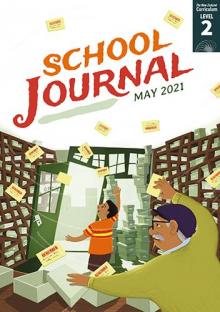
PDFs of all the texts in this issue of the School Journal are available online as well as teacher support materials (TSM) and audio for the following:
| Audio | TSM | ||
| Articles | Choie Sew Hoy: Otago Pioneer | ✔ | ✔ |
| The Memory Toolbox | ✔ | ✔ | |
| Stories | The Memory Bank | ✔ | |
| Bawang Putih and Bawang Merah | ✔ | ||
| Poem | What do you Remember? | ✔ |
Look inside this issue
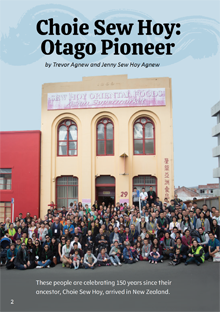
Choie Sew Hoy: Otago Pioneer
by Trevor Agnew and Jenny Sew Hoy Agnew
Choie Sew Hoy came to New Zealand from China in 1869, after working in the goldfields of California and Australia. He became a successful merchant and entrepreneur in Otago and was prominent in public life. He was also a well-known leader and benefactor for the Otago Chinese community. In 2019, 250 of his descendants came together in Dunedin for a family reunion to celebrate 150 years since their forebear arrived in New Zealand. Choie Sew Hoy is one of many early immigrants who made an important contribution to New Zealand society. Sew Hoy’s story explores the idea that people from a variety of countries came to make Aotearoa home and whether their experiences were positive or negative depended on how the migrants were treated.
Series: School Journal Level 2 May 2021
Learning area: Social Sciences
Curriculum level: 2
Reading year level: 4
Category: Non-fiction
Related titles: See TSM
Topics: ancestor, Aotearoa New Zealand’s histories, business, Chinese, Choie Sew Hoy, citizenship, community, descendant, dredge, entrepreneur, export, family, gold, goldmining, goldminers, history, immigration, import, merchant, miner, Otago, pioneer, racism, reunion
In: School Journal Level 2 May 2021
Publication date: May 2021
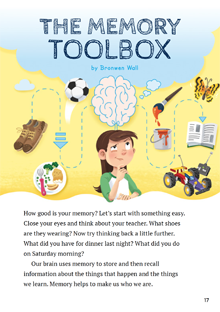
The Memory Toolbox
by Bronwen Wall; illustrations by Minky Stapleton
This article explains the difference between short-term and long-term memory and describes various techniques for improving memory, such as using acronyms, chunking information, and making word associations. It includes a sidebar about memory championships. In addition to being a fascinating topic in its own right, the suggestions for brain exercises could have practical applications for students.
Series: School Journal Level 2 May 2021
Learning area: Health and Physical Education
Curriculum level: 2
Reading year level: 4
Category: Non-fiction
Related titles: See TSM
Topics: acronym, information, long-term memory, memory, memory palace, memory technique, mind, remembering, short-term memory, study, world memory championships
In: School Journal Level 2 May 2021
Publication date: May 2021
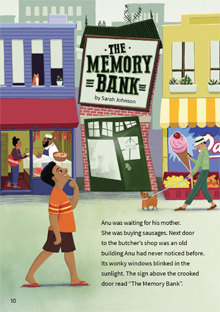
The Memory Bank
by Sarah Johnson; illustrations by Scott Pearson
This is a humorous fantasy story set in a “memory bank”. A breakdown in the filing system leads to confusion when the characters’ reminder notes get mixed up. This story links to the non-fiction text “The Memory Toolbox” and the poem “What Do You Remember?”, which are also in this journal. It provides a model for developing effective characters and storylines.
Series: School Journal Level 2 May 2021
Learning area: English
Curriculum level: 2
Reading year level: 4
Category: Fiction
Related titles: See TSM
Topics: bank, confusion, fantasy, helping, humour, memory, mix-up, remembering, safety
In: School Journal Level 2 May 2021
Publication date: May 2021
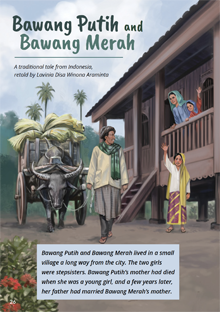
Bawang Putih and Bawang Merah
A traditional tale from Indonesia, retold by Lavinia Disa Winona Araminta; illustrations by Scott Pearson
This story is a popular children’s story in Indonesia and Malaysia. There are several different versions. Bawang Merah and Bawang Putih are stepsisters – one good and selfless, the other greedy and selfish. In the course of the story, the good sister is rewarded and the selfish sister is taught a lesson and sees the error of her ways. The story allows students with Indonesian and Malaysian heritage to see themselves reflected in the journal by including a familiar story from their own culture.
Series: School Journal Level 2 May 2021
Learning area: English, Social Sciences
Curriculum level: 2
Reading year level: 4
Category: Fiction
Related titles: See TSM
Topics: evil, fairy tale, family, good, greed, Indonesia, magic, moral, reward, stepmother, stepsister, traditional tale, trust, virtue
In: School Journal Level 2 May 2021
Publication date: May 2021
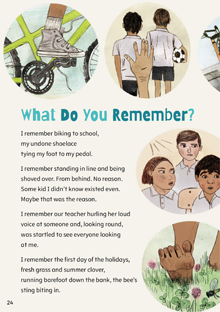
What do you Remember?
by James Brown; illustrations by Lisa Baudry
This poem is a collection of memories – the poet thinking about a number of events in his life, which are presented as a series of vivid images from specific moments that have stuck in his mind. The poem links to “The Memory Toolbox” and “The Memory Bank” in this journal. It shows how the same topic can be approached in different ways. It also provides a model for students’ poetic writing.
Series: School Journal Level 2 May 2021
Learning area: English
Curriculum level: 2
Reading year level: 4
Category: Fiction
Related titles: See TSM
Topics: childhood, friendship, imagery, language, memories, moment, poetry, school, stanza, verse
In: School Journal Level 2 May 2021
Publication date: May 2021


 Literacy Online home
Literacy Online home
